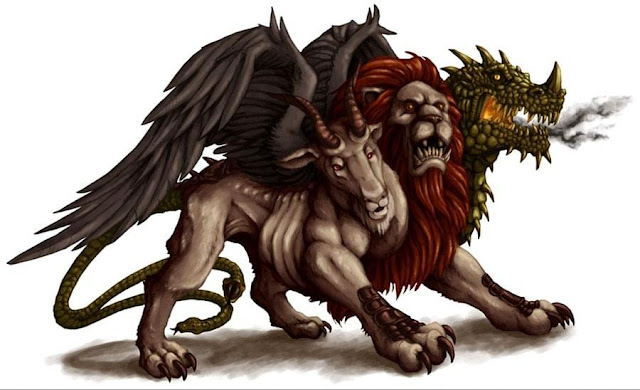The Chimaera was a hybrid monster in Greek mythology, child of Typhon and Echidna and sibling of Cerberus and the Lernaean Hydra. It had the head and body of a lion, as well as the head of a goat that was attached to its back, and a tail that ended on a head of a snake.
It resided in Lycia, a place in Asia Minor, where it ravaged the lands with its fire breath. It was killed by Bellerophon, assisted by Pegasus, when the former was asked by King Iobates of Lycia.
Bellerophon rode on Pegasus' back, who could fly, and shot arrows at the Chimera from above.
Homer's brief description in the Iliad: "a thing of immortal make, not human, lion-fronted and snake behind, a goat in the middle, and snorting out the breath of the terrible flame of bright fire." Elsewhere in the Iliad, Homer attributes the rearing of Chimera to Amisodorus. Hesiod's Theogony follows the Homeric description: he makes the Chimera the issue of Echidna: "She was the mother of Chimaera who breathed raging fire, a creature fearful, great, swift-footed and strong, who had three heads, one of a grim-eyed lion; in her hinderpart, a dragon; and in her middle, a goat, breathing forth a fearful blast of blazing fire. Her did Pegasus and noble Bellerophon slay." The author of the Bibliotheca concurs: descriptions agree that she breathed fire. The Chimera is generally considered to have been female (see the quotation from Hesiod above) despite the mane adorning her head, the inclusion of a close mane often was depicted on lionesses, but the ears always were visible (that does not occur with depictions of male lions). Sighting the Chimera was an omen of storms, shipwrecks, and natural disasters (particularly volcanoes).
Gold reel, possibly an ear-stud, with winged Pegasus (outer band) and the Chimera (inner band), Magna Graecia or Etruria, fourth century BC (Louvre)
While there are different genealogies, in one version the Chimera mated with her brother Orthrus and was the mother of the Sphinx and the Nemean lion (others have Orthrus and their mother, Echidna, mating; most attribute all to Typhon and Echidna).
It resided in Lycia, a place in Asia Minor, where it ravaged the lands with its fire breath. It was killed by Bellerophon, assisted by Pegasus, when the former was asked by King Iobates of Lycia.
Bellerophon rode on Pegasus' back, who could fly, and shot arrows at the Chimera from above.
Homer's brief description in the Iliad: "a thing of immortal make, not human, lion-fronted and snake behind, a goat in the middle, and snorting out the breath of the terrible flame of bright fire." Elsewhere in the Iliad, Homer attributes the rearing of Chimera to Amisodorus. Hesiod's Theogony follows the Homeric description: he makes the Chimera the issue of Echidna: "She was the mother of Chimaera who breathed raging fire, a creature fearful, great, swift-footed and strong, who had three heads, one of a grim-eyed lion; in her hinderpart, a dragon; and in her middle, a goat, breathing forth a fearful blast of blazing fire. Her did Pegasus and noble Bellerophon slay." The author of the Bibliotheca concurs: descriptions agree that she breathed fire. The Chimera is generally considered to have been female (see the quotation from Hesiod above) despite the mane adorning her head, the inclusion of a close mane often was depicted on lionesses, but the ears always were visible (that does not occur with depictions of male lions). Sighting the Chimera was an omen of storms, shipwrecks, and natural disasters (particularly volcanoes).
While there are different genealogies, in one version the Chimera mated with her brother Orthrus and was the mother of the Sphinx and the Nemean lion (others have Orthrus and their mother, Echidna, mating; most attribute all to Typhon and Echidna).

Comments
Post a Comment